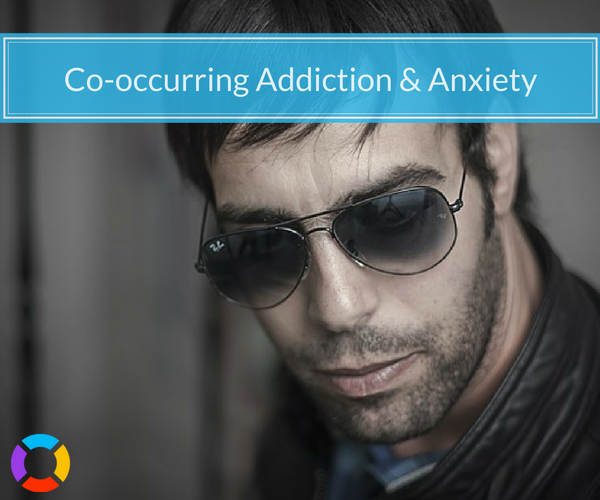Generalized Anxiety Disorder and Addiction

Between juggling family obligations, work responsibilities, crushing debt and current news events, it’s no surprise that generalized anxiety disorder (GAD) is one of the most common mental health diagnoses in America.
Imbalances in lifestyle, behavior and brain chemistry can be treated professionally with medication and psychotherapy. Unfortunately, many people attempt to manage their anxiety by self medicating through the use of illicit drugs.
This article will help you understand how generalized anxiety disorder and addiction co-occur and can evolve into a dual diagnosis condition, what signs and symptoms to look for and how and where to get treatment.
Struggling to manage daily anxiety?
Download the free GAD Daily Coping Checklist to track symptoms, practice grounding techniques and build healthier routines-one step at a time.
What is Generalized Anxiety Disorder (GAD)?
GAD is the acronym for Generalized Anxiety Disorder. GAD is when someone worries about a lot of things all at once and cannot stop. To worry means you are in a state of anxiety and uncertainty over actual or potential problems and be obsessed with controlling that which cannot be controlled.
A substance induced anxiety disorder can result as withdrawal from misused substances occurs. A dual-diagnosis anxiety disorder with addiction results when an individual has an anxiety diagnosis and starts misusing a prescription that was intended to manage the anxiety diagnosis.
Call to ask about available treatment options.
What are the Characteristics of Someone with GAD?
GAD is defined by the DSM-5-TR as “having three or more of these symptoms for at least six months, regarding several events or activities. It is when worry is hard to control and causes significant distress or impairment of social, occupational and other areas of life”.
These symptoms include:
- Restlessness or feeling on edge
- Easily fatigued
- Difficulty concentrating or blanking out mentally
- Irritability
- Muscle tension
- Sleep disturbances such as having a hard time falling asleep or staying asleep, restless sleep or feeling tired after sleeping all night
- The symptoms cannot be attributed to any other mental, physiological or substance related disorder
- The disturbance is not better explained by another mental health disorder, including bipolar disorder, schizophrenia, delusional or body dysmorphic disorder.
What Causes GAD?
- Genetic Origins: Personality may play a role in GAD. Sometimes GAD runs in families and is an inherited trait. As well, introverted people may have a greater propensity for GAD than extroverted people.
- Brain Chemistry: plays a role in all mental health conditions. It can be too much of or not enough of specific hormones or chemicals. Medication can help manage mental health conditions, including GAD, by balancing brain chemistry to work more effectively.
- Environmental Factors: that cause stress are causes of anxiety. Environmental factors may include extended exposure to violence, abuse or neglect.
- Trauma: Long term exposure to trauma can cause a person to develop unhealthy coping skills around how they deal with fear.
Fear activates the fight, flight or freeze response. When these methods of survival fail, they learn to fawn. Fawning is a form of compliance that allows the intensity of the survival instinct to be more tolerable. Trauma survivors often have anxiety disorders due to this compensation.
GAD Symptoms and Signs
People with GAD may worry about their job, their children, their parents, their siblings, their pets, their health and their finances when everything is actually status quo. They can worry about being late and pleasing other people. They cannot make their anxiety stop through relaxation.
Common Symptoms of GAD
Individuals with GAD experience a wide range of symptoms, including:
- Persistent worrying, anxiety, overthinking, inability to relax or difficulty with concentration
- Indecisiveness, fear and difficulty handling uncertainty
- Fatigue, trouble sleeping and irritability
- Muscle tension or aches, trembling or being easily startled
- Sweating
- Nausea, diarrhea or irritable bowel syndrome.
The symptoms of generalized anxiety disorder and substance use are not different for men and women. However, the frequency of reporting, seeking treatment and recovery can be very different for each gender.
GAD Symptoms in Women
Women are more likely to experience anxiety and seek treatment for a mental health crisis than men. Anxiety may also be caused by hormonal changes like pregnancy, menopause or after a hysterectomy. Women are less likely to seek treatment for substance use due to family obligations.
GAD Symptoms in Men
Even though fewer men are diagnosed with anxiety than women, they will seek treatment for substance use more frequently. Men are generally less likely to admit to having mental health struggles due to ongoing social stigmas around false ideologies of weakness and strength.
Curious about GAD? Call now for help.
Statistics on Generalized Anxiety Disorder and Addiction
Prevalence of GAD in Adult Population
The SAMHSA National Survey for 2024 reported 21.7 percent of adults had mild to moderate symptoms of generalized anxiety disorder. That was 56.9 million people.
Older adults over 50 experience greater levels of generalized anxiety disorder than younger people. Over 60 million adults received treatment for mental health conditions in 2024.
The statistics for a co-occurring or dual diagnosis substance use disorder with a mental health diagnosis were around 8.1 percent of the adult population or 21.2 million people. The main course of treatment was medication, while less than 4 percent attended an outpatient treatment provider.
Hospitalization Risk
There is a small risk of inpatient hospitalization for mental health conditions, with less than 2 percent of people identifying with a mental health disorder seeking hospitalization. Most inpatient hospitalizations are for conditions involving psychosis or suicidal ideation.
Why Do GAD and Addiction Often Co-Occur?
Anxiety can result from a struggle with an ongoing undiagnosed problem that develops into a self medicating routine with illicit substances.
Addiction can occur when a person abuses their prescription medications for anxiety or begins seeking alternative sources of chemical intervention.
Anxiety as a Trigger for Substance Abuse.
People may start using substances before they even understand that they have an anxiety disorder to cope with the uncomfortable feelings. An anxiety disorder may also develop because of extended use of illicit substances, causing changes in brain chemistry.
Self Medication Cycle
The cycle of self-medication begins with the misuse of alcohol, drugs or nicotine. Individuals misuse these substances to try to avoid uncomfortable feelings. As a person starts self medicating to feel better, brain chemistry changes and a physical, emotional and psychological dependence can develop.
Brain Chemistry and Dopamine
Individuals with GAD have unbalanced brain chemistry, especially dopamine regulation. Dopamine is the neurotransmitter responsible for motivation, reward and pleasure, attention and focus and memory.
For people with GAD, their brains become hypersensitive to stress and perceived danger, while addiction disrupts their reward system. This begins a cycle of worry, seeking relief and dependence.
Short Term and Long Term Effects of GAD and Addiction
Short Term Impacts
Individuals with GAD and addiction can face many overlapping symptoms. These include anxiety, insomnia, sleep disturbances and other health issues. A person experiencing these symptoms may seek relief from alcohol or drugs, starting a cycle of use that can lead to a substance use disorder.
Also, when a person with addiction is going through the detox process, they often experience elevated levels of anxiety, compounding the problem.
Long Term Impacts
The long term impact of GAD and addiction includes brain chemistry changes that can worsen anxiety and associated disorders, including panic disorder and obsessive compulsive disorder. These extreme cases of anxiety can lead to a disruption in daily life, making it hard to socialize, work or even go out of the house.
Call today to speak with someone. You don’t need to recover alone.
Signs You or a Loved One May Have Substance Use and Anxiety
Co-Occurring Symptoms
If you or someone you love begins having problems with showing up to work, family gatherings or planned social meetings, they may have an increase in anxiety or substance abuse.
Other indicators that they are in trouble include:
- Tremors, shaking and nervous habits like chewing nails or skin on hands
- Excessive sleeping or not sleeping at all
- Behaviors that involve creating protection that go beyond normal safety measures
- Paranoia
- Using more medication than prescribed or misusing alcohol or illicit drugs
Managing GAD takes structure. Use the free Daily Anxiety Management Planner to set routines, log triggers and track progress. It is designed to keep you grounded even on tough days.
GAD Treatment and Recovery Options
Treatment for individuals with GAD and addiction includes detox if indicated, inpatient or outpatient treatment and medication management.
Detox for Anxiety and Addiction (Stabilization).
Medically assisted detox programs are available to ease symptoms of withdrawal from substances and in turn, reduce anxiety.
Inpatient Treatment for GAD and Addiction.
Inpatient treatment often follows completion of a detox program. Individuals participate in individual and group therapy that utilizes a mix of therapeutic approaches, including CBT, ACT, mindfulness practices and trauma informed care. All of which recognize the importance of treating both conditions for the best outcomes.
Outpatient Treatment for GAD and Addiction.
Individuals who do not require higher levels of care or have completed a comprehensive inpatient program can participate in an outpatient program to treat both GAD and addiction. Individuals will continue to receive a mix of therapeutic approaches to help them develop coping skills and emotional intelligence that address their dual diagnosis
Medication for GAD and Addiction
Several medications are helpful in the treatment of both GAD and addiction. These may include SSRIs, SNRIs, buspirone, beta-blockers, Suboxone and methadone.
Medically assisted treatment may be ongoing through outpatient programs and continue as long as necessary to ensure long term recovery.
How to Deal with GAD in Daily Life
Along with seeking professional help, there are several practices that you can do to make life with GAD a little easier.
- Eating healthy and keeping adequately hydrated
- Journaling, practicing gratitude or positive self thought
- Time blocking
- Mindfulness practices, meditation, yoga or breathing exercises
- Exercise
- Connecting with nature
- Creative outlets like painting, sewing, gardening or building something
- Staying connected with family, friends or support people
- Avoiding alcohol and substances as a coping mechanism
When to Seek Treatment Help
Most individuals will experience anxiety at different times in their lives.
It may be time to get help when:
- Your worrying interferes with your relationships, work commitments or other parts of your life like socialization.
- You have started to use or misuse substances to treat your symptoms of anxiety.
- You have thoughts of harming yourself or others. (Seek emergency care immediately).
Across the country, there are treatment programs that can help you create a life where GAD and addiction are no longer in control.
Conclusion: Hope for Generalized Anxiety Disorder and Addiction
GAD and addiction are both treatable conditions. Acknowledging that you need help is often the first and maybe the hardest step toward a life in recovery. Seeking help through counseling, treatment programs, medication and support groups can be the best decision you’ve ever made.
You don’t have to face GAD alone. Start today with the free Generalized Anxiety Daily Planner, a simple tool to help you stay organized, manage stress and support your recovery journey.
Websites like Detox.com offer a database where you can search for the program that is right for you. You can filter settings, medications offered, treatment programs and payment options and can find contact information for the facility.


